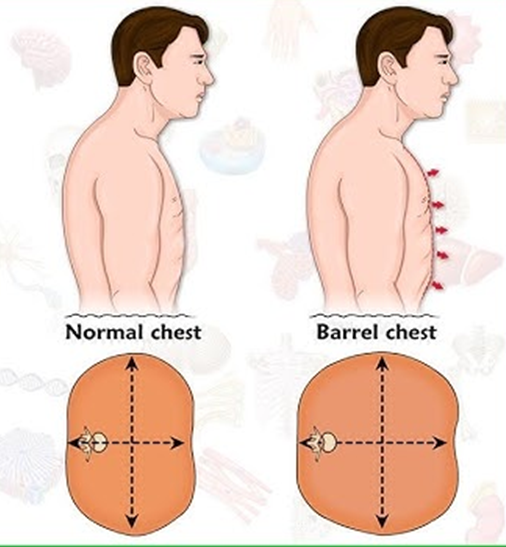While examining a client, the nurse observes the client's chest to be barrel-shaped. The nurse would interpret this as indicating which of the following?

Pigeon Chest
Pneumonia
Funnel Chest
COPD
The Correct Answer is D
Choice a reason:
Pigeon Chest, or pectus carinatum, is a condition where the breastbone is pushed outward, and the chest appears to protrude. It is not typically associated with a barrel-shaped chest, which is characterized by a rounded and bulging appearance.
Choice b reason:
Pneumonia is an infection that inflames the air sacs in one or both lungs, which may fill with fluid or pus. While it can cause chest expansion, it does not lead to a barrel-shaped chest. The barrel-shaped chest is more indicative of a chronic condition rather than an acute infection like pneumonia.
Choice c reason:
Funnel Chest, or pectus excavatum, is a condition where the breastbone is sunken into the chest. Unlike a barrel-shaped chest, funnel chest gives the chest a depressed appearance.
Choice d reason:
COPD, or Chronic Obstructive Pulmonary Disease, is commonly associated with a barrel-shaped chest. This shape results from the chronic hyperinflation of the lungs due to obstructive lung disease, which causes the rib cage to remain expanded.
Nursing Test Bank
Naxlex Comprehensive Predictor Exams
Related Questions
Correct Answer is B
Explanation
Choice a reason:
Immunization schedules are typically considered a part of primary prevention. They are intended to prevent diseases before they occur by using vaccines to provide immunity against infections.
Choice b reason:
Regular mammogram screenings are a form of secondary prevention. They are used to detect breast cancer lesions early before symptoms appear, which can lead to more effective treatment and better outcomes.
Choice c reason:
The consistent use of seat belts is a primary prevention strategy. It is a proactive measure to prevent injuries in the event of a motor vehicle accident.
Choice d reason:
Annual vision examinations can be considered part of secondary prevention if they are used to detect vision problems or eye diseases in their early stages. However, they can also be seen as primary prevention because they help maintain and protect eye health before issues arise.
Correct Answer is ["A","B","C","D"]
Explanation
Choice a reason:
Wearing nonslip shoes in the house can prevent falls, which are a common cause of traumatic brain injuries (TBIs) in adolescents. Falls often occur due to slippery surfaces, and nonslip shoes provide better traction, reducing the risk of such accidents.
Choice b reason:
Supervised use of guns by an adult is crucial to prevent accidental shootings, which can result in TBIs or even more severe outcomes. Adolescents may not fully understand the risks associated with handling firearms, and adult supervision ensures that safety measures are followed.
Choice c reason:
The consistent use of seat belts in vehicles is one of the most effective ways to prevent TBIs during car accidents. Seat belts keep occupants from being ejected or hitting the interior of the car, significantly reducing the risk of head injuries.
Choice d reason:
Avoiding risky activities such as snowboarding without proper safety measures can prevent sports-related TBIs. While snowboarding, wearing a helmet and other protective gear is essential to protect the head during falls or collisions.
Whether you are a student looking to ace your exams or a practicing nurse seeking to enhance your expertise , our nursing education contents will empower you with the confidence and competence to make a difference in the lives of patients and become a respected leader in the healthcare field.
Visit Naxlex, invest in your future and unlock endless possibilities with our unparalleled nursing education contents today
Report Wrong Answer on the Current Question
Do you disagree with the answer? If yes, what is your expected answer? Explain.
Kindly be descriptive with the issue you are facing.
